Wood species
On the following pages I try to give a - really short - overview of the woods I use.
Usually all woods used come "from the neighbour's garden" and are stored and dried by me until I can use and carve them. Sometimes there are special rarities, about which I have found only insufficient information, if at all. For example rhododendron or rose root tuber.
The only wood I buy is linden, as I have not found a source in my area yet.
For some of my works I even use glued wood - I will not describe it here. It is a very interesting material. It is a very soft, long fibered wood with a beautiful grain. But see for yourself in the "My works" section.
African Blackwood (Dalbergia melanoxylon), Mpingo is a deep darkbrown to almost black hard wood of the rosewood family with a very fine pattern (black sometimes a little bit violet).
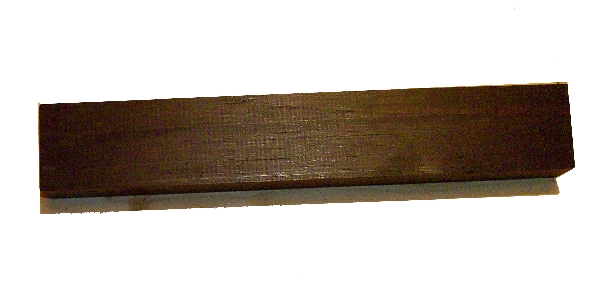 It is mainly imported from Mozambique and Tanzania. in earlier times it has wrongly been called senegal- or Mozambique-Ebony. But it doesn't belong to the ebony family.
It is mainly imported from Mozambique and Tanzania. in earlier times it has wrongly been called senegal- or Mozambique-Ebony. But it doesn't belong to the ebony family.
It was probably first brought to Europe at the beginning of the 16th Century by Portuguese. Since it has a permanent place in wind instruments - mainly for clarinets, oboes and flutes and traditionally the Great Highland Bagpipes.
The wood is almost famous for his absolutely outstanding sound characteristics. Because of its hardness and density, it provides a very harmonically rich and sharp sound.
Blackwood is one of the heaviest woods - it is so heavy that it does not even swim.
The dark heartwood is surrounded by a bright yellow, rather thin sapwood. The commonly used part of the tree is the heartwood. It is structured in a very fine and homogeneous way and feels smooth and has a slightly oily touch.
Because of its high density, it is impermeable to air. Due to the hardness one can make very precise and sharp edges. However, it is very difficult to work.
The special surface can be properly polished to a high gloss. However, this does not really accept to be oiled - the wood does not really soak in the oil, it stays on the surface.
When it is finishedd- oiled and polished - it often looks just black - to slight grain seems to be lost.
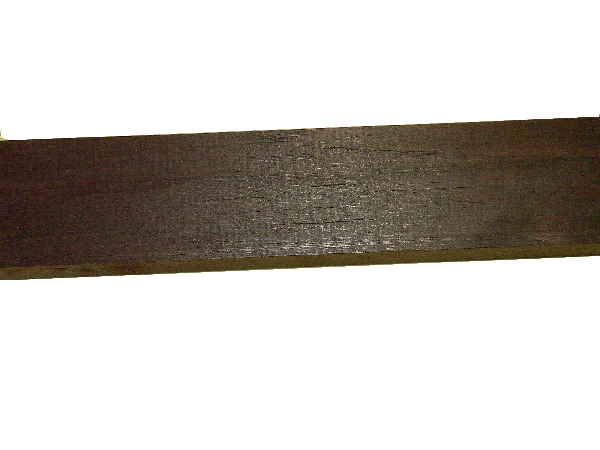
The juneberry (Amelanchier ovali) is actually a shrub. Their wood is dense, close-grained, tough and difficult to split.
more info will follow
weitere Infos folgen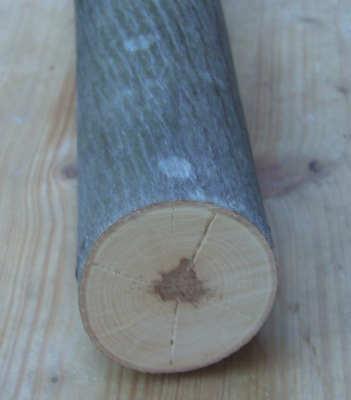
The staghorn sumac (Rhus typhina) is actually more like a bush, than a tree.
Its wood is rather light and soft - rather brittle. It can be carved very well. It is very decorative because of its color.
The wood has a very light, almost white sapwood. The core is striped green, a very very decorative clearly visible grain that makes the wood very popular especially for wood turners and other artists.
It is said that the wood had floureszent properties, it is highly luminous neon yellow under UV light. Sorry but I could not yet check this by myself.
In general, all parts of the plant are considered to be slightly toxic. You should wear a dust mask when working with it, especialyy while sawing and sanding. Even the wood should not be used for children's toys.
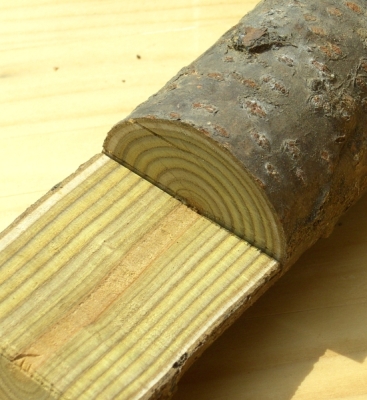
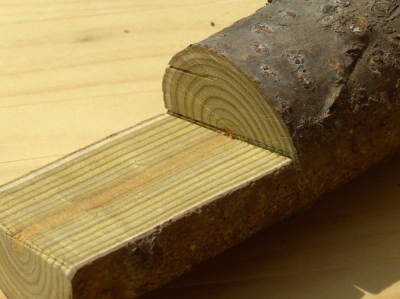
Ash (Fraxinus excelsior / common Ash) is spread all over Europ and is one of the hoghest treas among the decidous trees.
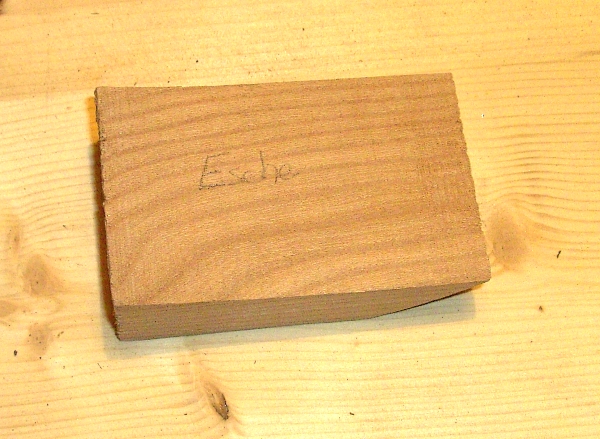 The wood is hard, long fibered and very elastic. In general, it is irregularly striped. It's good workable and has a very high load capacity.
The wood is hard, long fibered and very elastic. In general, it is irregularly striped. It's good workable and has a very high load capacity.
The wood can be found in the furniture industry or boat building, but also for the production of baseball bats and qeues..
American ash is gray-brown with a slight reddish tint.
The common ash has a whitish sapwood which is not always distinguished from the heartwood color (yellowish to reddish white). The grain is straight, the wood structure rather coarse.
Ash wood is ring porous, and the annual ring are clearly visible. The wood dries fairly rapidly with little loss of quality. It is easy to glue and takes stains and polishes good.
Ebony is not native european wood.
I got some small pieces of ebony as a gift. That's why I decided to write about it here and I tried to find out some facts about this wood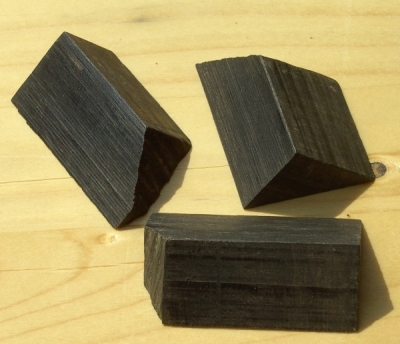
It is one of the most expensive woods. If we hear of ebony we think that this wood should be consistently deep black, in fact there are different types and they may vary in color. There is for example ebony that has a dark green, dark brown to reddish color - it is even available in white
Becuase of its hardness it is really difficultto work with. It also tends to tear out and to splinter. The heartwood has no visible growth rings and it is very hard and heavy. The sap woodis kind of yellow-gray and is rather considered as worthless and therefore rarely traded.
When working with this wood one should should wear a respirator because the dust from sanding may cause irritation of skin, lungs and eyes.
Folgende Sorten gibt es (Quelle: Wikipedia):
- Ceylon-Ebenholz (Diospyros ebenum) ist die beste, heute kaum noch verfügbare Qualität: sehr hart, gut polierbar, praktisch ohne wahrnehmbare Poren, gut bearbeitbar, witterungs- und termitenfest. Das Ebenholz des Möbelbaus im 16.–19. Jahrhundert war von dieser Sorte.
- Madagaskar-Ebenholz (Diospyros perrieri) ist von eher dunkelbrauner Farbe, es ist sehr feinporig, witterungsfest, termitenfest und hat eine Dichte von ca. 1,0 kg/dm³.
- Makassar-Ebenholz (Diospyros celebica) (Indonesien) zählt zu den „farbigen“ Ebenhölzern und ist im Splint gelblichweiß, im Kernholz schwarz mit sehr charakteristischen hellgelb bis braungestreiften längsverlaufenden Maserungen; es ist sehr dicht und farbbeständig, sein Schleifstaub verursacht wie der aller Ebenhölzer Reizungen der Haut, Augen und Lunge. Seine Dichte beträgt 1,1 bis 1,3 kg/dm³. Im englischen Sprachraum wird es auch als Coromandelholz oder Marblewood bezeichnet.
- Mun-Ebenholz (Diospyros mun) kommt aus Laos und Vietnam und ist ähnlich wie Makassar-Ebenholz zweifarbig gestreift.
Page 4 of 6



